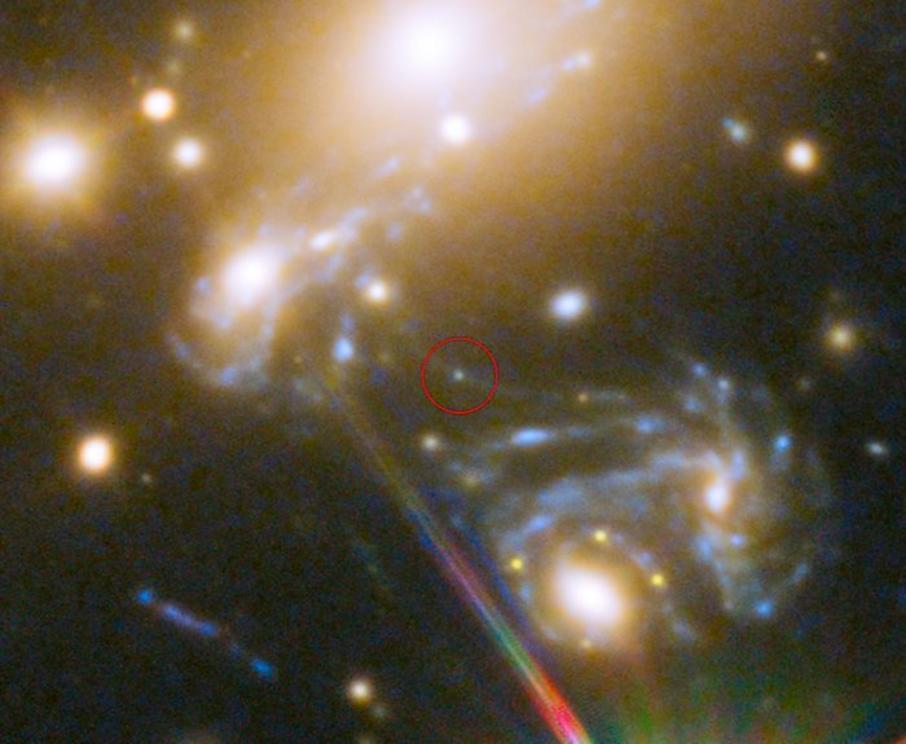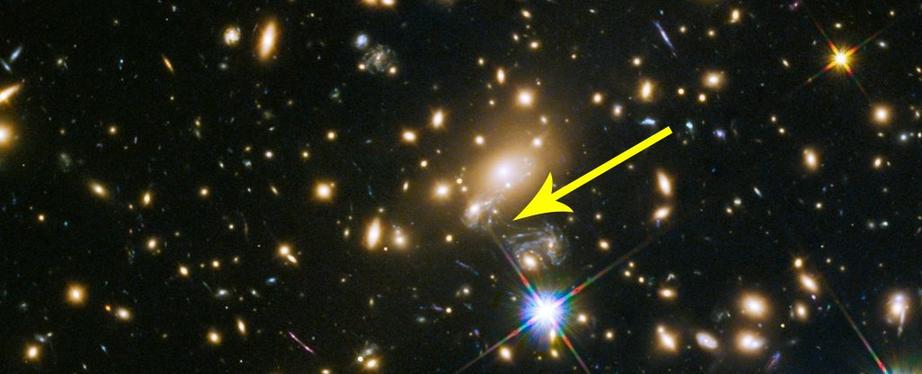Thanks to incredible luck, Hubble caught a photo of the most distant star ever seen
Hubble has obtained an absolutely amazing photograph - a blue giant star called Icarus 9 billion light-years from our Solar System, the farthest individual star ever seen. And it's all thanks to a rare alignment of cosmic objects called gravitational lensing.
Previously, Hubble has imaged some impressively distant galaxies. In April 2016, it snapped the most distant galaxy ever, Gn-Z11, 13.4 billion light-years away - just 400 million years after the Big Bang.
But galaxies are a lot bigger and brighter than the individual stars within them. After a distance of about 100 million light-years away, stars are impossible to see individually.
Icarus, however, is special. It's been magnified by objects in front of it so massive that they bend light - and it's the first star to be imaged in this way.
"This is the first time we're seeing a magnified, individual star," said study leader Patrick Kelly, formerly of the University of California at Berkeley postdoc and now at the University of Minnesota, Twin Cities.
"You can see individual galaxies out there, but this star is at least 100 times farther away than the next individual star we can study, except for supernova explosions."
Directly in between Hubble and Icarus is a galaxy cluster called MACS J1149+2223, about 5 billion light-years away. This cluster is absolutely massive, and this mass creates a strong gravitational field in the space around it.
When light passes through this gravitational field, it bends. This creates a magnifying effect called gravitational lensing, which allows us to see objects that wouldn't normally be visible, or visible in such strong detail.
But this lensing is still dependent on exactly the right alignment of objects.
 Icarus, magnified by lensing and microlensing. (NASA, ESA, et al.)
Icarus, magnified by lensing and microlensing. (NASA, ESA, et al.)
MACS J1149+2223 generally magnifies Icarus - real name MACS J1149+2223 Lensed Star 1, or LS1 for short - around 600 times. Even this is too faint to be picked up by Hubble.
Thankfully, the lensing effect of the galaxy cluster was amplified by an object within the cluster that provided a second lensing effect - allowing for Icarus to be seen by us.
We don't actually know precisely what that amplifying object is, but we know it's around three times the mass of the Sun - which means it's probably a star. A single star or compact massive object inside a foreground lens, if precisely aligned with the object behind it, can magnify the background object thousands of times.
This is called gravitational microlensing, and it is what temporarily magnified Icarus by a factor of over 2,000. But the microlensing didn't just have implications for Icarus.
"The discovery of LS1 allows us to gather new insights into the constituents of the galaxy cluster," explained co-author Steven Rodney from the University of South Carolina.
"We know that the microlensing was caused by either a star, a neutron star, or a stellar-mass black hole."
The team originally detected the star in 2016 when they were using Hubble to observe a nearby supernova called SN Refsdal, also being magnified by the galaxy cluster. Because of its position in the sky, the team thought the new object must be more highly magnified than the supernova, so they analysed its light.
This is how they determined it was a star. It wasn't getting hotter like a supernova - the light was staying steady - and its signature matched that of a blue giant. These are large, hot and very bright stars, up to hundreds of thousands of times brighter than the Sun.
Icarus is probably a B-type supergiant, an extremely luminous star with a surface temperature somewhere between 11,000 and 14,000 degrees Celsius - more than twice as hot as the Sun.
So the concatenation of circumstances that led to this photo was incredibly lucky.
- The star was a very bright blue giant
- Between us and the star was a galaxy cluster
- In the galaxy cluster was a microlensing star that passed by
- We just happened to be looking at the right time
But observations from October 2016 showed a second image of the star - which means that as the stars in the galaxy cluster move around, it may be visible again many times in the future.
The findings have been published in Nature Astronomy.

